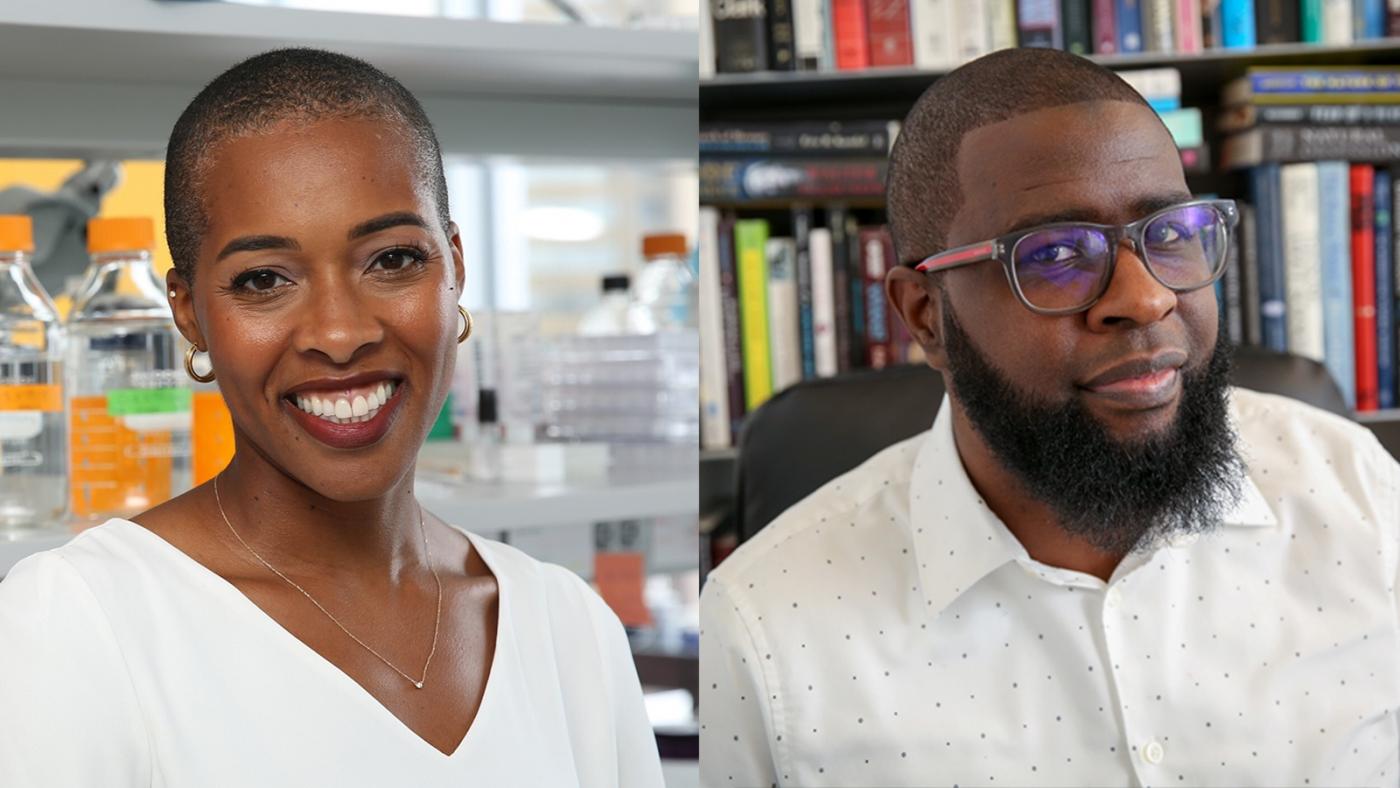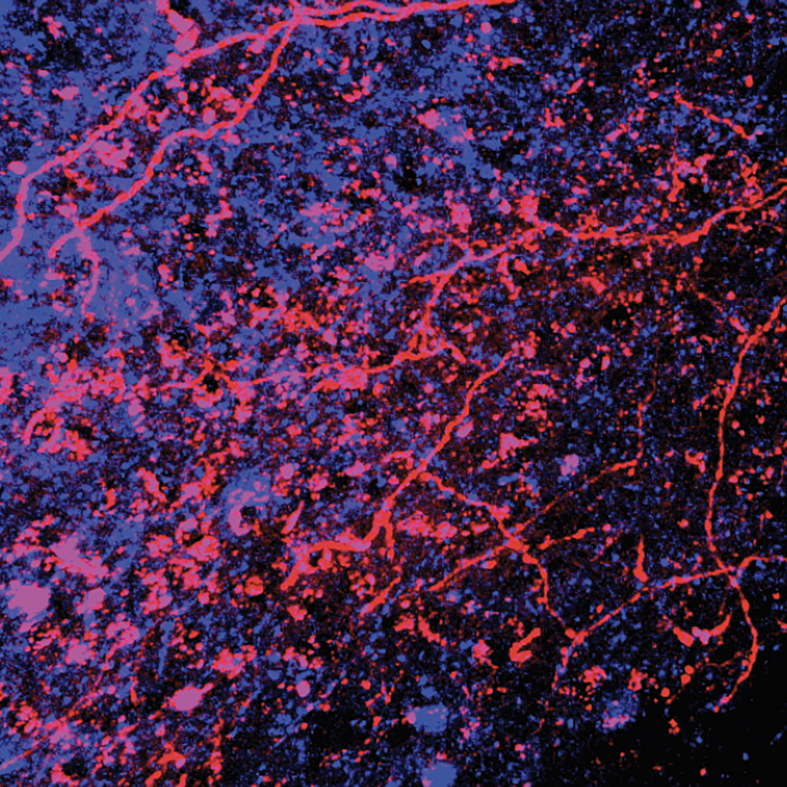Two neuroscientists at Columbia’s Zuckerman Institute who focus on foundational research and foster a culture of mentorship and inclusivity in their labs have won support from a new, ambitious Howard Hughes Medical Institute program.
Bianca Jones Marlin, PhD, studies the parental experience and how learned information in mice can be biologically passed to offspring. Ishmail Abdus-Saboor, PhD, is uncovering, also in rodents, the neural mechanisms underlying pleasurable and painful touch. Today, both were named to HHMI's inaugural class of Freeman Hrabowski Scholars.
The new roughly $1.5-billion HHMI grant program is named after the former president of the University of Maryland, Baltimore County, legendary for increasing opportunities into science, engineering and medicine for people from underrepresented groups in these fields. Each Freeman Hrabowski Scholar appointment is for five years, with the potential for renewal for another five years and for funding close to $9 million. The program aims to boost momentum in the scientific community for embracing and enacting diversity, equity and inclusion.
We asked Drs. Marlin and Abdus-Saboor separately about their research, laboratory cultures and how the HHMI Freeman Hrabowski Scholars Program is likely to influence their scientific journeys.
What does becoming an HHMI Freeman Hrabowski Scholar mean for you, for your lab and for science?
Dr. Marlin The Freeman Hrabowski Scholars Program enables us to change the culture of science. It enables labs like mine, which focus on career development opportunities and the wellbeing of our team members, while simultaneously driving forward radical and rigorous science. The program underscores the important notion that we can be both exceptional scientists and excellent human beings. We are now able to answer some of our field’s most exciting research questions faster and more thoroughly, and the support provided by this award will allow us to invite more people from diverse backgrounds into the experience of science.
Dr. Abdus-Saboor This is the greatest honor of my career. This 10-year investment allows my lab to dream even bigger and go after challenging problems that may take years to tackle. In addition, I am now forever linked to one of my heroes, Dr. Freeman Hrabowski. I have idolized him for years and share in his passion and belief that we can change the status quo in science to unlock everyone’s potential. I hope I can make Dr. Freeman Hrabowski proud with my science and advocacy.
How do you describe the lab culture you are creating and nurturing?
Dr. Marlin I approach my research and lab holistically. I want the Marlin lab to be a place of joy and of discovery. My mantra is to perform science that is radical and rigorous, ambitious and meticulous. It’s important that my lab is a safe place with a healthy mental state where successes and failures are equally informative and valued. As scientists, we have the privilege and honor to explore the world, whether it’s the world we walk through every day or the world inside our heads.
I hope the larger scientific community can evolve to the point where inclusive and supportive cultures are the norm, and where we no longer need to talk about the lab environment so that we can focus entirely on doing groundbreaking science. This can happen if we create compassionate and enriching spaces in which you can be productive, know that you are accepted, receive thoughtful and tailored support, and embrace the opportunity to build bridges beyond the lab to accomplish whatever goals you might have. We trust that when we walk into a building we are going to stand on floors that are not going to crumble under our feet. Our lab environments should be the same way. They should serve as infrastructure we can count on completely.
Dr. Abdus-Saboor I try to empower each and every individual in my lab, from postdocs to undergraduates, to believe that they are important and that their ideas matter. We have removed hierarchies. We spend a lot of time just thinking and talking about science, bouncing ideas off of each other, debating and respectfully challenging each other. Who knows where our next greatest idea will come from?
We also embrace our science in a fearless way. I encourage members of my lab to value mistakes, to see them not as failures but opportunities to learn. I have cultivated an environment where we are not out to one-up or compete with each other, but to just support each other. I won’t be able to unlock my colleagues’ creativity and support their well-being if they are stressed, tired or feel like they merely are cogs in the wheel of the PI. To the best of my ability, I try to help my younger colleagues get the skills and connections they need to achieve their career goals, in or out of academia.
I believe happy and healthy people innovate at the highest levels. So we try to make sure everyone is fulfilled intellectually, physically and mentally, and we encourage healthy habits inside and outside of the lab. I see myself as a coach, a cheerleader, a motivator and someone who tries to set people up for success.
What sort of research are you focusing on now in your lab?
Dr. Marlin My research thus far has focused on recording individual brain cells in mice and trying to figure out how an animal’s experience changes the behavior of those cells. I am working to uncover how those experience-driven changes in the brain cells can get passed on to the cells of the next generation, a process called “transgenerational epigenetic inheritance.” We are also working with collaborators using functional Magnetic Resonance Imaging (fMRI) to explore whole-brain changes during the parental experience. For example, we are investigating what happens when a naive female mouse, who has not had pups and who is aggressive toward them, later becomes a caring mouse mother. What changes in the brain when an organism transitions to being a parent?
We can ask the same questions about stressful and traumatic experiences, which in human contexts can correspond to conditions like poverty, neglect and violence. What does the whole brain look like when you have an adrenaline rush and you learn that a stimulus evokes fear of negative consequences? How does that experience influence the whole adult body, including the sperm and eggs, and affect the brains and bodies of the next generation?
In the near future, we will also study the placenta of birthing mice, or what I refer to as “the third brain.” We will investigate how this organ of pregnancy mediates the transmission of both the mother’s and father’s life experiences to their offspring–a research question with profound implications for our understanding of parenting, wellbeing and societal mental health.
Dr. Abdus-Saboor Our work is centered around understanding the skin-brain axis for tactile sensations. We have three areas that we are really excited about pursuing with this investment from HHMI. First, building upon our recent studies in mice, we will investigate what brain areas accompany the transition from acute to chronic pain. Second, we will harness our expertise and continue to identify behaviors, genes and neural circuits, from the skin to the brain, that are critical for socially rewarding touch. Finally, we are now studying the East African naked mole rat to understand how the skin-brain axis for touch shapes this animal’s extremely cooperative social structure.
A longer term research goal, I call it a dream experiment, is to devise a capability to simultaneously measure cellular activity from peripheral sensory ganglia where we first detect painful and rewarding touch, the spinal cord that connects the peripheral nervous system to the brain, and the brain where the neurobiology supporting our perceptions unfolds. We want to observe this whole circuit in action all at once. This will require building new kinds of microscopes that we don’t have now. Data of this sort could reveal yet more about how touch works, while opening a new window on potential therapeutic interventions for managing pain.


